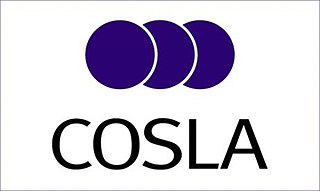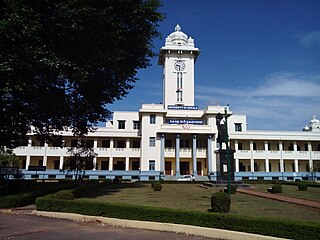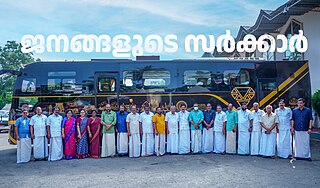
The Kerala model refers to the practices adopted by the Indian state of Kerala to further human development. It is characterised by results showing strong social indicators when compared to the rest of the country such as high literacy and life expectancy rates, highly improved access to healthcare, and low infant mortality and birth rates. Despite having a lower per capita income, the state is sometimes compared to developed countries. These achievements along with the factors responsible for such achievements have been considered characteristic results of the Kerala model. Academic literature discusses the primary factors underlying the success of the Kerala model as its decentralization efforts, the political mobilization of the poor, and the active involvement of civil society organizations in the planning and implementation of development policies.

The Convention of Scottish Local Authorities (COSLA) is the national association of Scottish councils and acts as an employers' association for its 32 member authorities.

Kerala Sasthra Sahithya Parishad (KSSP) (lit. 'Kerala Science Literature Movement') is a prominent science and literature organization based in the Indian state of Kerala. It was founded in 1962 with the aim of promoting scientific temper, rational thinking, and a scientific approach to societal issues. The organization has played a significant role in popularizing science and scientific knowledge among the general public, particularly in the Malayalam-speaking region.

Literacy in India is a key for social-economic progress. The 2011 census, indicated a 2001–2011 literacy growth of 97.2%, which is slower than the growth seen during the previous decade. An old analytical 1990 study estimated that it would take until 2060 for India to achieve universal literacy at then-current rate of progress.

The importance and antiquity of education in Kerala are underscored by the state's ranking as among the most literate in the country. The educational transformation of Kerala was triggered by the efforts of both Church Mission Society missionaries like Jon Munro and clergy of Catholic church like Fr Kuriakose Elias Chavara and Fr Charles Lavigne and were the pioneers that promoted mass education in Kerala, in the early decades of the 19th century. The local dynastic precursors of modern-day Kerala, primarily the Travancore Royal Family, the Nair Service Society, Sree Narayana Dharma Paripalana Yogam, and Muslim Educational Society (MES), also made significant contributions to the progress on education in Kerala. Local schools were known by the general term kalaris, some of which taught martial arts, but other village schools run by Ezhuthachans were for imparting general education. Christian missionaries and British rule brought the modern school education system to Kerala. Ezhuthu palli was the name used in earlier times. The word was derived from the schools run by the Buddhist monasteries. For centuries, villages used to set up an ezhuthupally or ashan pallikoodam with one or two teachers. Students used to go this school from nearby areas and learn languages, literature, mathematics, grammar etc. After completing this, students may continue study about specific subjects such as ayurveda, astrology, accounting etc. Censuses during the 1800s showed that Travancore, Cochin, and Kannur areas have many such schools.
Kerala is a state on the southwestern coast of India. It is known for its high literacy rate, low infant mortality rate, and long life expectancy.

Perinad is a village in Kollam district in the state of Kerala, India. As of 2001 India census, Perinad had a population of 32,864 with 16,032 males and 16,832 females.
Community-based monitoring (CBM) is a form of public oversight, ideally driven by local information needs and community values, to increase the accountability and quality of social services such as health, development aid, or to contribute to the management of natural resources. Within the CBM framework, members of a community affected by a social program or environmental change track this change and its local impacts, and generate demands, suggestions, critiques and data that they then act on, including by feeding back to the organization implementing the program or managing the environmental change. For a Toolkit on Community-Based Monitoring methodology with a focus on community oversight of infrastructure projects, see www.communitymonitoring.org. For a library of resources relating to community-based monitoring of tropical forests, see forestcompass.org/how/resources.

Common Service Centres (CSCs) are a key component of the Digital India initiative launched by the Government of India. These centres aim to provide essential government and non-government services to citizens, particularly in rural and remote areas, through digital means. By acting as access points for various public utility services, social welfare schemes, healthcare, financial, and education services, CSCs play a crucial role in the digital empowerment of the underserved populations.

The National Health Mission (NHM) was launched by the government of India in 2013 subsuming the National Rural Health Mission and National Urban Health Mission. It was further extended in March 2018, to continue until March 2020. It is headed by Mission Director and monitored by National Level Monitors appointed by the Government of India.Rural Health Mission (NRHM) and the recently launched National Urban Health Mission (NUHM). Main program components include Health System Strengthening (RMNCH+A) in rural and urban areas- Reproductive-Maternal- Neonatal-Child and Adolescent Health, and Communicable and Non-Communicable Diseases. NHM envisages achievement of universal access to equitable, affordable and quality health care services that are accountable and responsive to the needs of the people.

The Student Police Cadet (SPC) Project is a high school-based initiative by Kerala Police, implemented jointly by the Departments of Home and Education, and supported by Departments of Excise, Transport, Forest, and Local Self-Government. Student Police Cadet Project was initiated in 2010, as a joint program of education, health, transport, forest, excise, tribal development and local self-governments. This well designed two-year long training programme, enables high school students to sharpen their physical, emotional, intelligence, social and skills quotients through a wide range of activities such as exercises, parade, route march, unarmed compact yoga and community projects.
The Banyan is a non-governmental organization based in Chennai, India that was founded in 1993 by Vandana Gopikumar and Vaishnavi Jayakumar to cater to mentally-ill and homeless women in the city.

Koduvayur is a Census Town and Grama Panchayat in Palakkad district in the state of Kerala, India. Koduvayur Panchayat comprises Koduvayur-I and Koduvayur-II villages. As of the 2011 Census of India, Koduvayur-I village had a population of 20,703 spread over an area of 11.47 km2 (4.43 sq mi). It is one of the major commercial centre in the district and is located about 11 km from Palakkad through State Highway 27. It is part of the decentralized administrative system in India, aimed at ensuring local development and governance in rural areas. Koduvayur serves as an important centre for governance and public administration at the village.

Healthcare in Belize is provided through both public and private healthcare systems. The Ministry of Health (MoH) is the government agency responsible for overseeing the entire health sector and is also the largest provider of public health services in Belize. The MoH offers affordable care to a majority of Belizeans with a strong focus on providing quality healthcare through a range of public programs and institutions.
Kerala State Biodiversity Board (KSBB)

Digital India is a campaign launched by the Government of India to make its services available to citizens electronically via improved online infrastructure and by increasing Internet connectivity. The initiative includes plans to connect rural areas with high-speed internet networks. It consists of three core components: the development of secure and stable digital infrastructure, delivering government services digitally, and universal digital literacy.

First Pinarayi Vijayan ministry is the Council of Ministers headed by Pinarayi Vijayan that was formed after the Left Democratic Front (LDF) won the 2016 Kerala Legislative Assembly elections. The Council assumed office on 25 May 2016. The ministry had a total of 19 ministers in the Cabinet at the time of swearing-in compared to 21 ministers in the previous government. Pinarayi Vijayan sworn in as 22nd Chief Minister of Kerala, 12th person to hold this position. Chief Minister Pinarayi Vijayan on 3 May 2021 submitted the resignation of the Council of Ministers headed by him to Governor Arif Mohammed Khan after winning a historic victory in the 15th legislative assembly elections by winning 99 of the 140 seats in the Assembly.

Nava Kerala Mission is an initiative of the Pinarayi Vijayan-led Government of Kerala launched in November 2016. The initiative seeks to address problems faced in four key social sectors, namely, health, education, agriculture and housing, with the help and involvement of local self-governments. The Mission was officially launched by P. Sathasivam, Governor of Kerala, in a meeting held in Thiruvananthapuram on 10 November 2016.

Second Pinarayi Vijayan Ministry is the Council of Ministers headed by Pinarayi Vijayan that was formed after winning in the 15th legislative assembly elections by bagging 99 of the 140 seats in the Assembly. The Council assumed office on 20 May 2021. The ministry is having a total of 21 ministers in the Cabinet compared to 20 ministers in the previous government.
Kudumbashree is a poverty eradication and women empowerment programme implemented by the Government of Kerala. Kudumbashree has a three-tier structure for its women community network, with Neighborhood Groups (NHGs) at the lowest level, Area Development Societies (ADS) at the middle level, and Community Development Societies (CDS) at the local government level.














